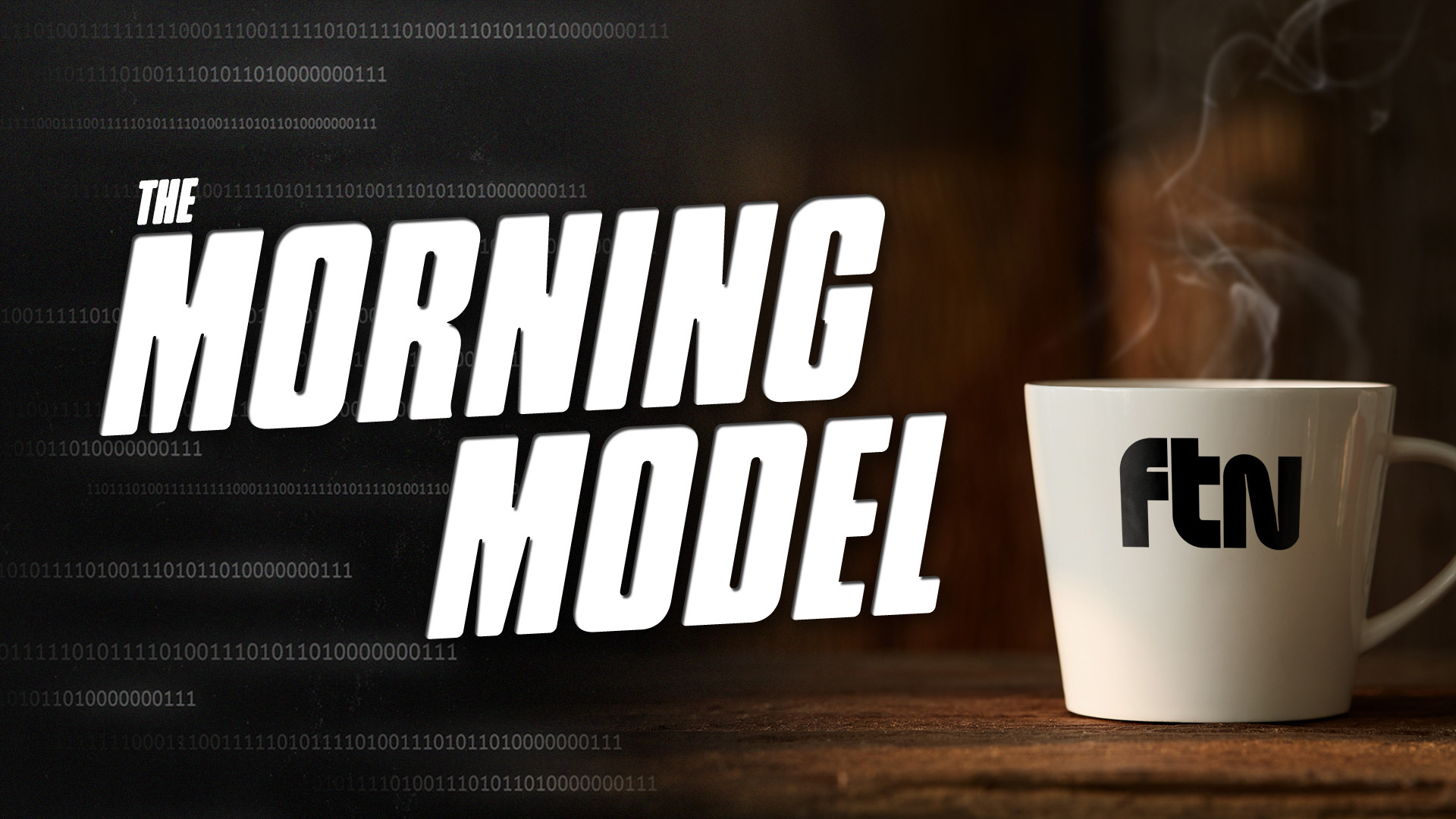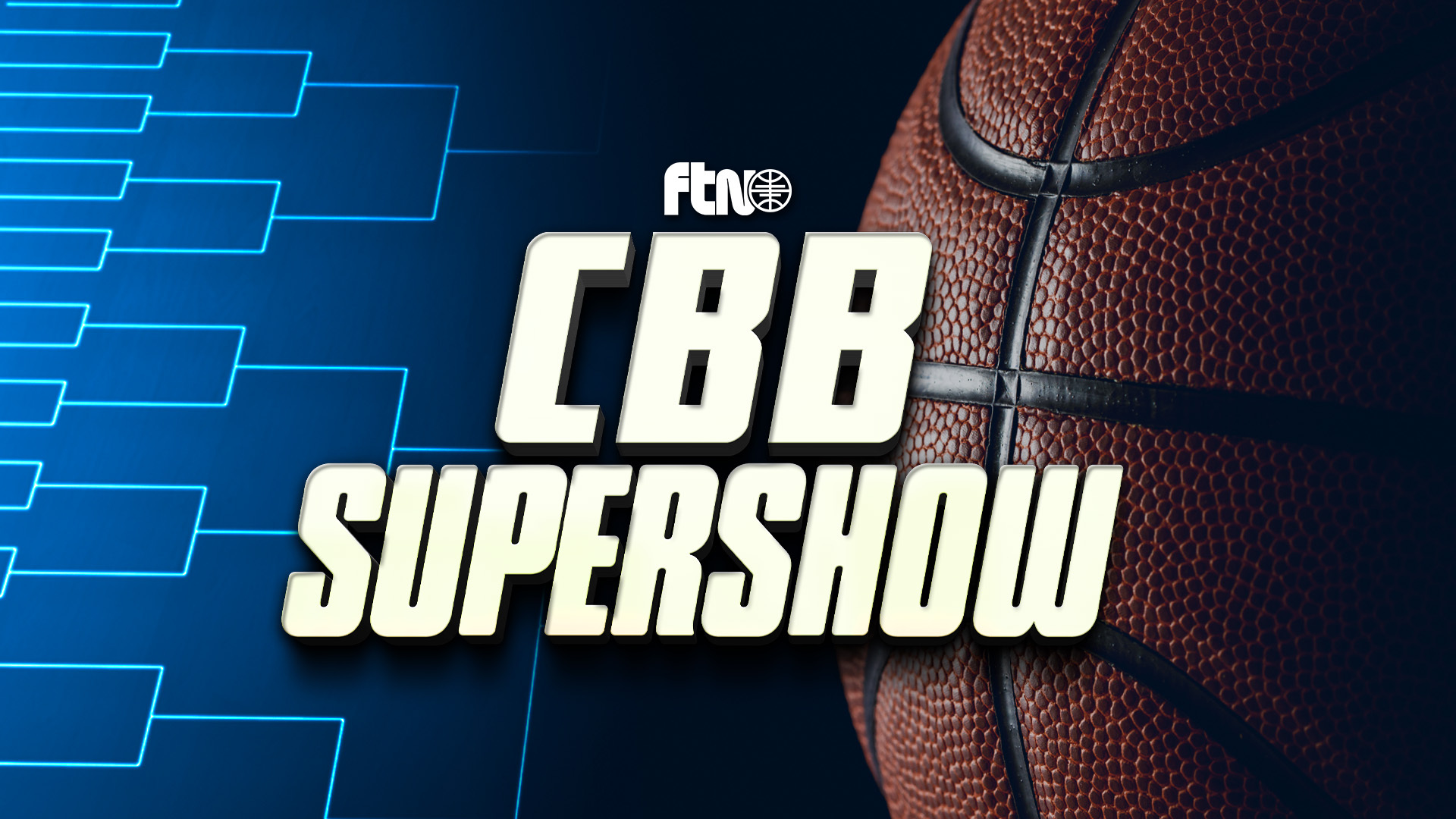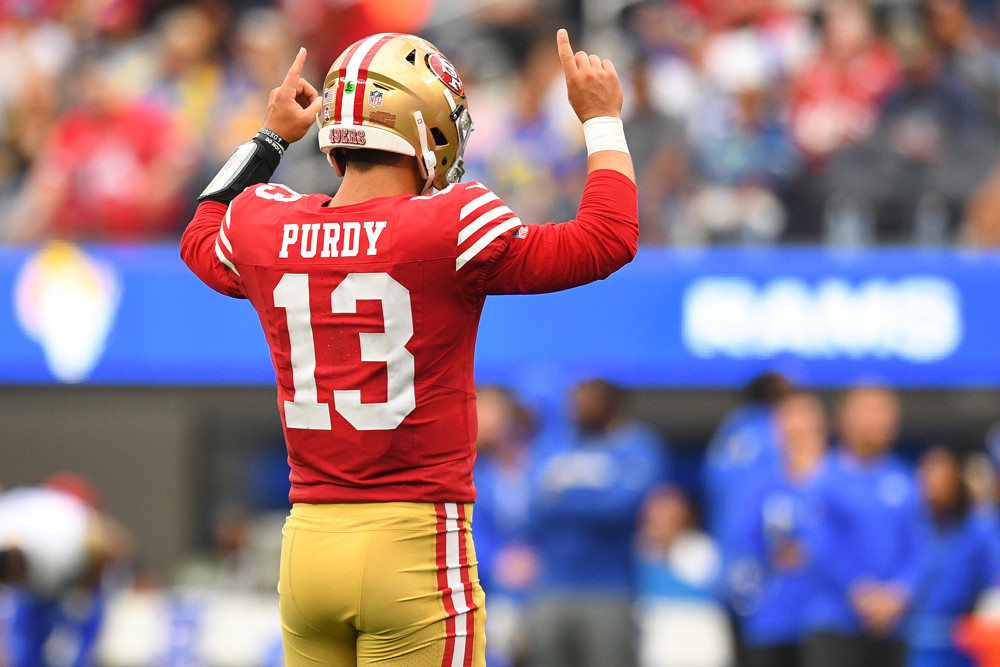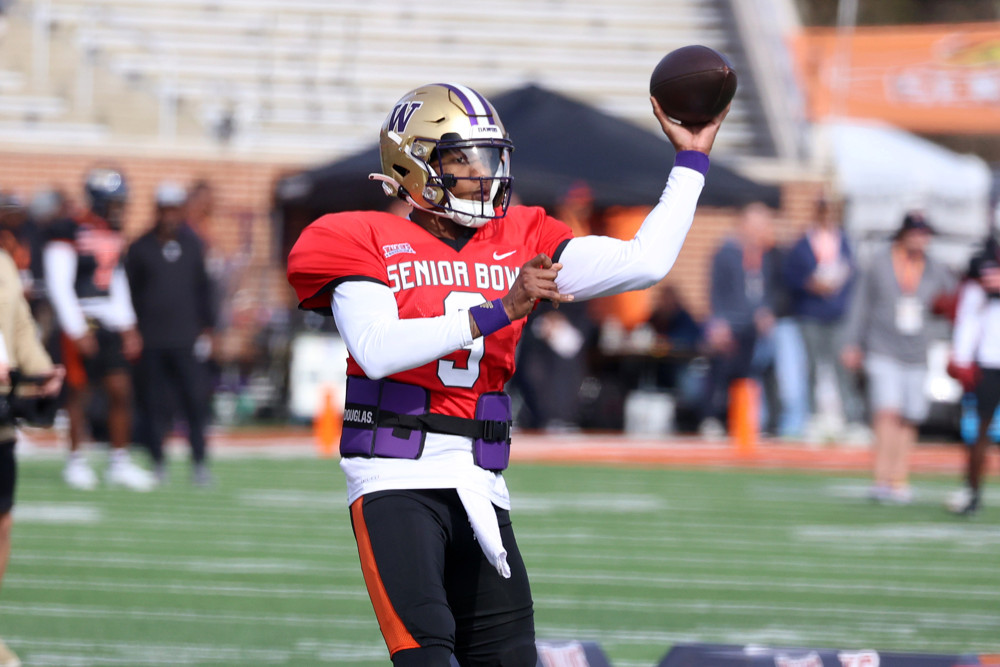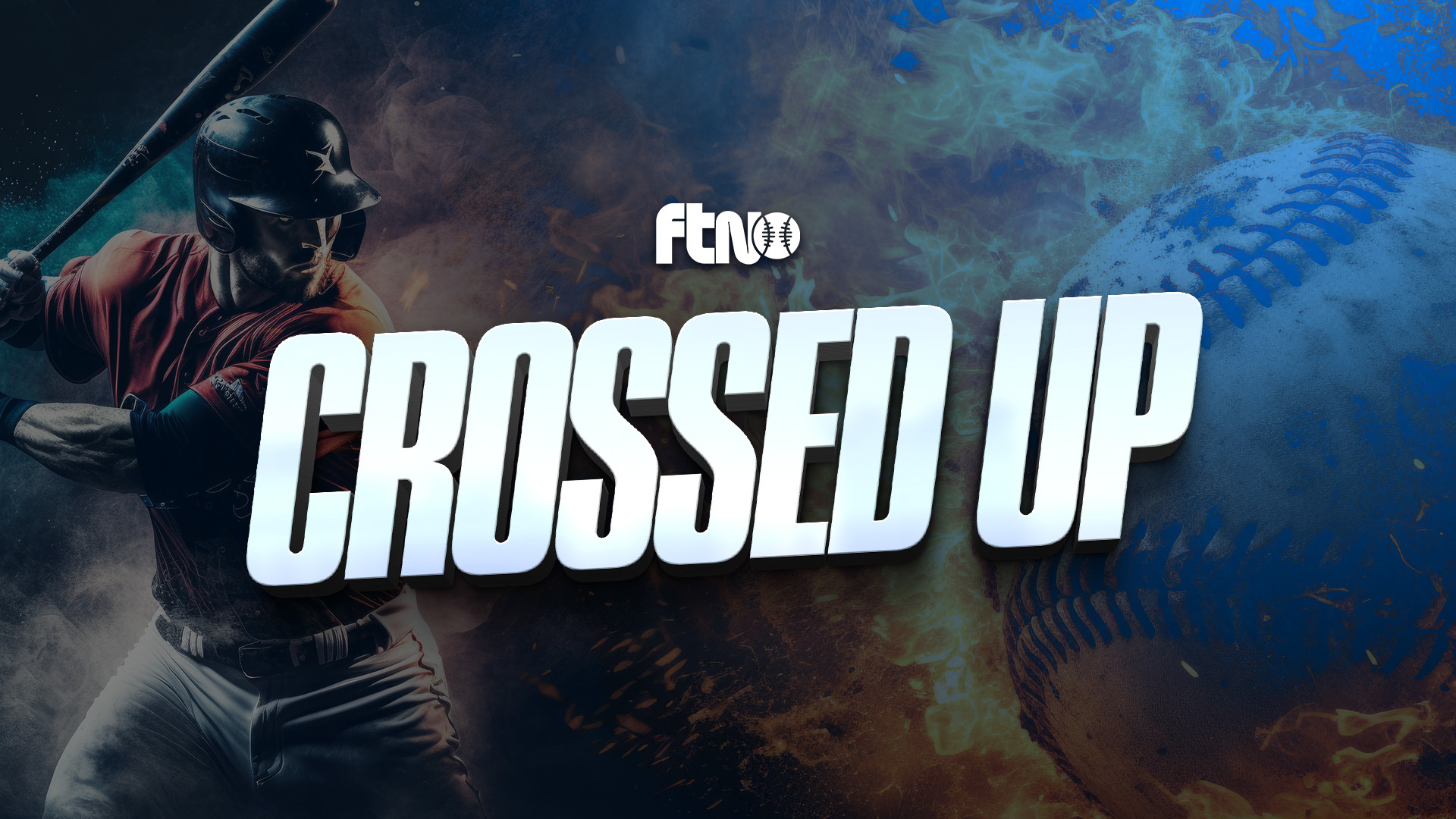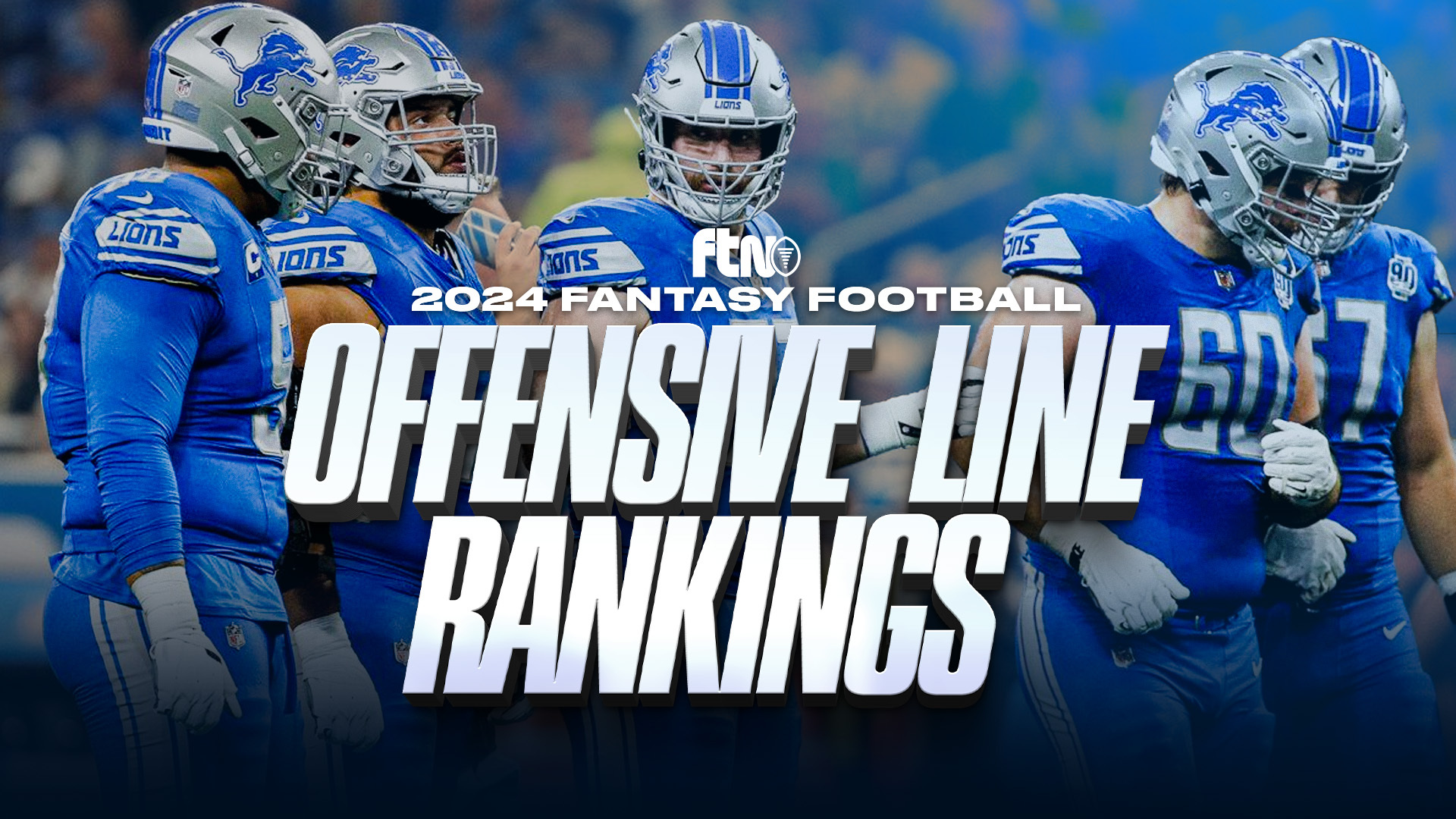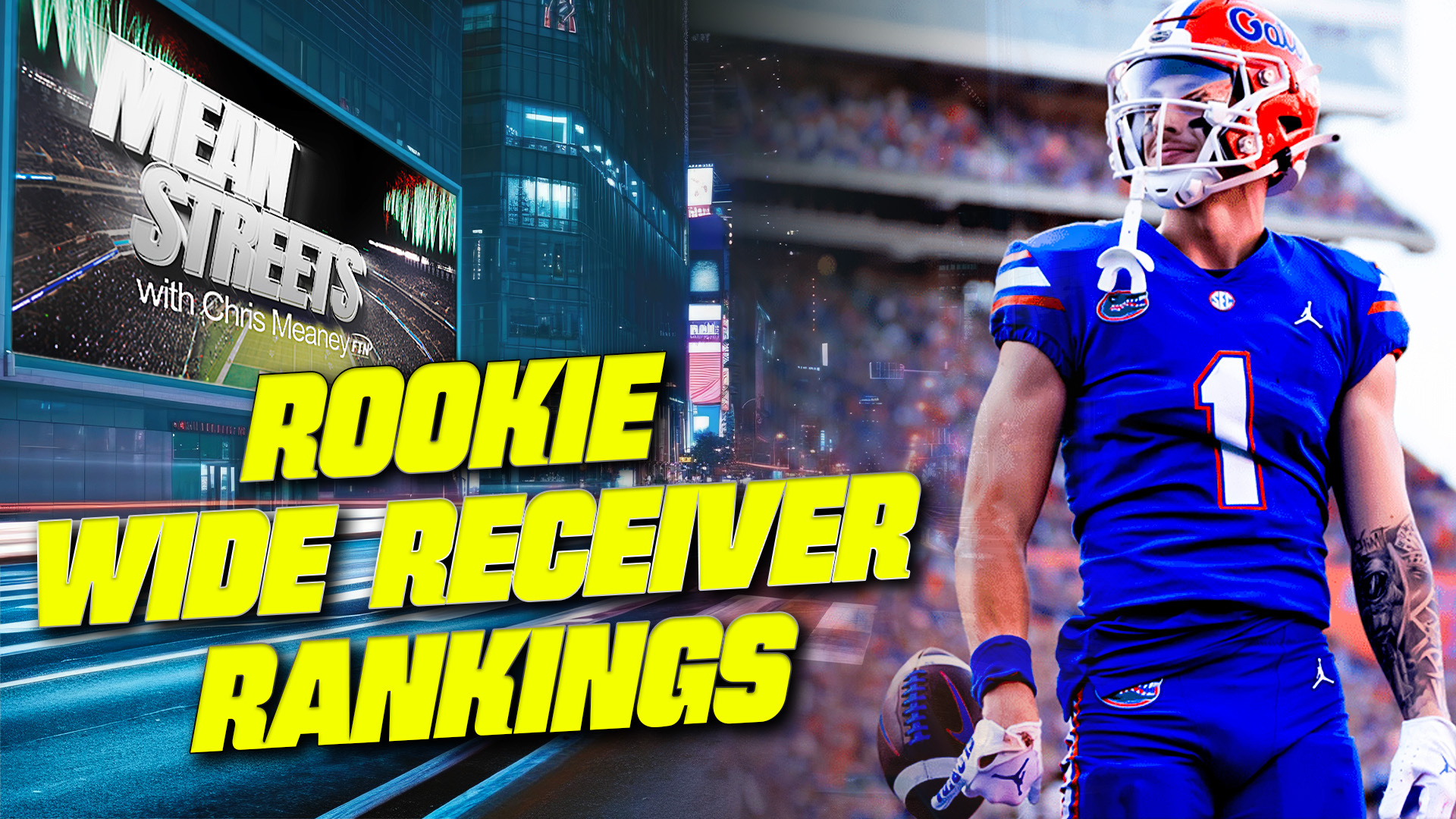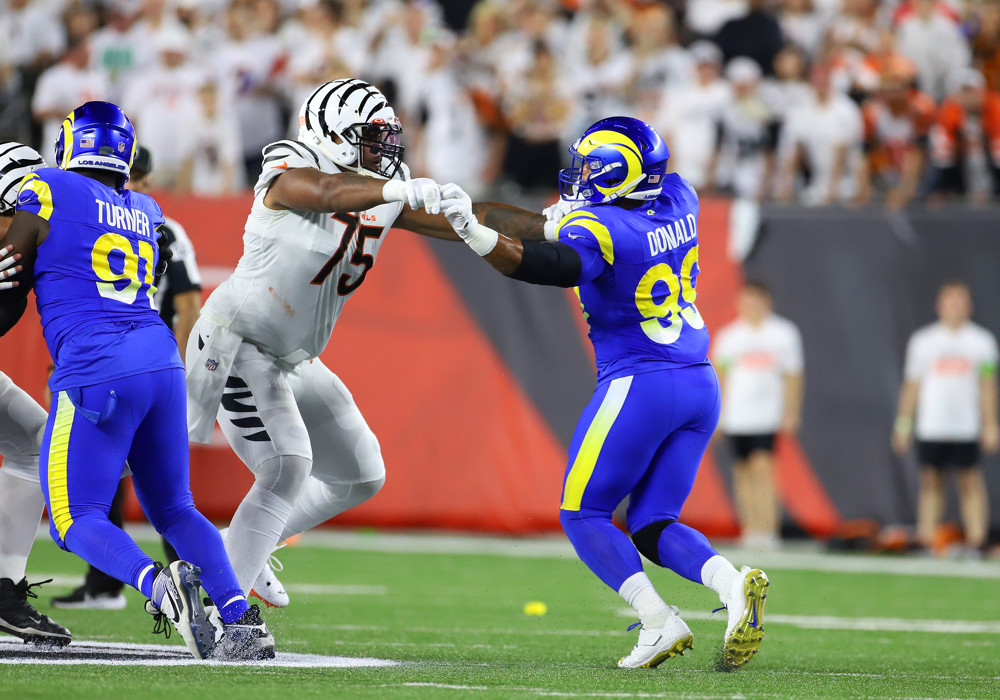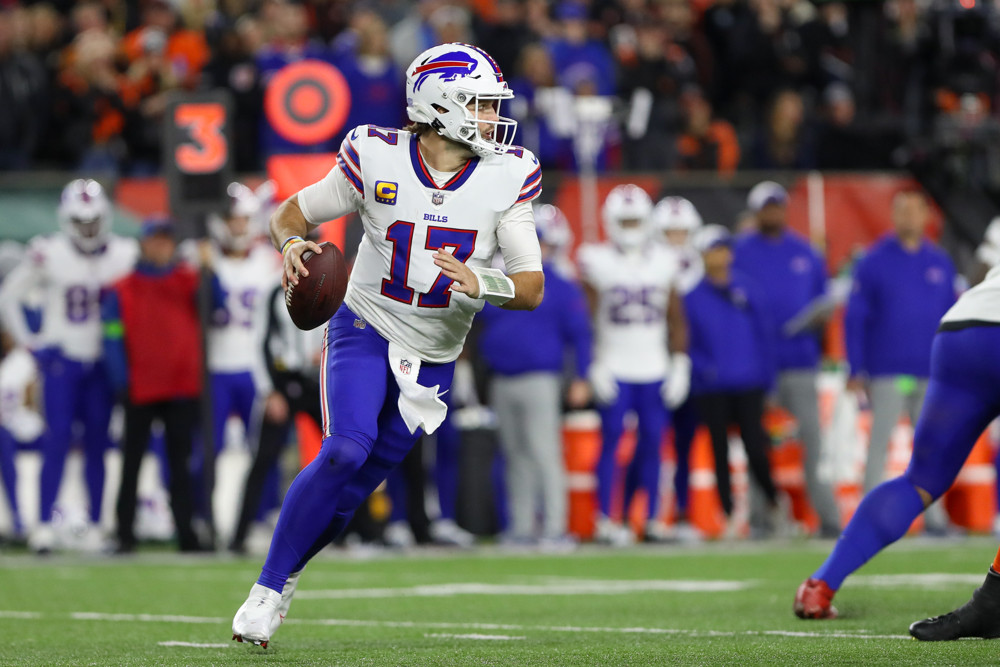
Well, here we are again with the question of whether we have to consider Patrick Mahomes as “playoff LeBron.” Does Mahomes specifically raise his game in the playoffs, to the point where we can’t accurately analyze the Super Bowl LVIII matchup because we can’t use past statistics to determine Kansas City’s strengths and weaknesses?
Last week, I noted that Mahomes really just had one great game in this year’s playoffs, the game against Buffalo. Now it’s one and a half great games, since he was fantastic in the first half against a very tough Baltimore defense. When you look at the trend for the entire season, though, this performance in the playoffs is really just a return to how well Mahomes was playing at the beginning of the year. Mahomes had a few good games in the first few weeks before the Chiefs offense started having all kinds of problems with the receivers. Things have rebounded now in the playoffs:
| Patrick Mahomes Pass DVOA by Week, 2023 | |||
| Weeks | DVOA | NY/P | Int% |
| Weeks 1-7 | 35.2% | 7.50 | 2.3% |
| Weeks 8-17 | -7.5% | 5.82 | 2.4% |
| Weeks 19-21 | 40.6% | 6.60 | 0.0% |
The other important stat for the playoffs is that last one, the 0.0% under interception rate. That’s the biggest difference between Mahomes in the regular season and Mahomes in this year’s playoffs. He’s not turning over the ball at all, or even coming close. According to FTN Data charting, Mahomes had 21 “interception-worthy throws” during the 2023 regular season. In the playoffs, he has zero. How likely is that to continue for another game? I suppose it depends on whether you believe in Playoff Mahomes Magic or not.
When ESPN asked its analysts to give a first reaction Super Bowl pick on Sunday night, my first response was to take the Chiefs. The answer was less the Mahomes Magic and more the decline of the 49ers defense in the second half of the season. However, I looked closer at this decline. In some ways, it is an artifact of two things. First, that the 49ers played a tougher schedule of opposing offenses in the second half of the year (and of course in the playoffs). Second, it’s the effect of Week 18 when the 49ers backups didn’t play as well against Carson Wentz and the Rams. On the other hand, the Chiefs backups played very well that same week against Easton Stick and the Chargers.
However, it’s clear the 49ers defense has been very mediocre in the past few games. Consistently mediocre, in fact. Check out the week-to-week graph for the 49ers below and you’ll see that San Francisco’s last five games (one of which was the Week 18 game) all hover around 0% for defense.

Here’s a table looking at the DVOA for both the San Francisco and Kansas City defenses, split at midseason but with Week 18 removed. This is a particularly apt split because 49ers safety Talanoa Hufanga was injured early in Week 11 against Tampa Bay. It looks like San Francisco’s defense hasn’t declined, as long as you adjust for opponent strength. (The Chiefs defense also played a harder schedule in the second half of the year.) But the 49ers haven’t played a game with defensive DVOA better than -20% since Week 12 against Seattle.
| KC and SF Defenses DVOA by Week, 2023 | |||||||
| Weeks | Team | DVOA | Rk | Pass | Rk | Run | Rk |
| Weeks 1-10 | KC | -8.5% | 7 | -12.1% | 3 | -3.1% | 24 |
| Weeks 11-17, 19-21 | KC | -8.7% | 8 | -15.5% | 3 | 0.8% | 25 |
| Weeks 1-10 | SF | -7.2% | 8 | -8.1% | 5 | -5.4% | 20 |
| Weeks 11-17, 19-21 | SF | -10.3% | 6 | -12.7% | 6 | -6.5% | 19 |
That table also displays one of the major storylines for this game, which is that both defenses were better against the pass than the run this year. That’s not just an issue of rank. Running plays were actually more efficient against these defenses than passing plays, which is rare.
Another storyline for this game that’s easier to discuss for both offenses together: these teams excel at gaining yards after the catch. San Francisco (6.5) and Kansas City (6.4) were first and second in average yards after the catch this season. They were also both better than average on defense at 4.8 YAC and they faced a similar average depth of target from opponents. In particular, San Francisco was second in lowest YAC allowed to tight ends (3.9) while Kansas City was better in lowest YAC allowed to running backs, sixth at 7.2. They were similar in average YAC allowed to wide receivers.
As you would expect from defenses that didn’t allow a lot of yards after the catch, both defenses were very strong on tackles. PFR has the 49ers as the second-best defense in terms of broken tackles per touch, while the Chiefs are seventh.
All stats are for the regular season only except for weighted DVOA and anything else noted below. Week-to-week charts represent that team’s single-game total DVOA, now separated into offense and defense for each team. The extra line is a rolling five-week average. If you’re checking out FTN’s DVOA for the first time, it’s explained right here.
| KC (14-6) | SF (14-5) | |
| DVOA | 17.9% (5) | 39.4% (2) |
| WEI DVOA | 23.8% (3) | 34.4% (2) |
| Chiefs on Offense | ||
| KC OFF | SF DEF | |
| DVOA | 10.0% (8) | -9.6% (4) |
| WEI DVOA | 9.2% (8) | -5.6% (8) |
| PASS | 25.9% (8) | -9.4% (4) |
| RUSH | -5.4% (17) | -10.1% (15) |
| 49ers on Offense | ||
| KC DEF | SF OFF | |
| DVOA | -5.0% (7) | 31.8% (1) |
| WEI DVOA | -11.7% (4) | 31.8% (1) |
| PASS | -7.2% (5) | 57.7% (1) |
| RUSH | -1.7% (27) | 17.3% (2) |
| Special Teams | ||
| KC | SF | |
| DVOA | 2.9% (6) | -2.0% (25) |
WHEN THE CHIEFS HAVE THE BALL
For the most part, I’m going to look at the matchups on this side of the ball as if there is no such thing as Playoff Mahomes Magic, and the last three games just happened to add three good games to Mahomes’ season record. Those three games certainly make the Kansas City offense look better this season, but under this theory, their overall performance is a better predictor of their Super Bowl performance than just looking at the last two or three games. You also may notice that the Chiefs’ weighted offensive DVOA is slightly lower than their total offensive DVOA from the regular season, even with those playoff games added in. The Chiefs offense declined in the second half of the year, no question about it. It was just over a month ago when they lost to the Raiders at home, 20-14. From Week 8 through Week 16, the Chiefs were held to 21 points or lower in six out of eight games.
The 49ers pass defense wasn’t quite as good as the Chiefs pass defense this season, but it was close. The 49ers ranked in the top 10 vs. all five types of receivers that I track, including fourth against tight ends. San Francisco was also 10th against wide receivers lined up wide and eighth against wide receivers from the slot. A weakness against deep passes from past seasons has gone away, as the 49ers ranked eighth against deep passes this season. And the 49ers are the No. 1 defense against passes up the middle, thanks in large part to linebackers Fred Warner and Dre Greenlaw.
Patrick Mahomes was average on middle passes during the regular season but he’s been fantastic on middle passes in the postseason: 10-for-17, 11.5 yards per pass, and almost all first downs.

The 49ers defense ranked fifth in zone but 12th in man. But that matches the Chiefs offense, which was 20th against man but seventh against zone during the regular season. None of the 49ers cornerbacks stand out as particularly better or worse with the new cornerback coverage DVOA. They all come out a little bit above average. They all were better in the second half of the year.
One surprise is that San Francisco’s pressure rate has gone down since Chase Young arrived, based on FTN Data charting. They had a pressure rate of 36.3% (fourth) before Week 10 and a pressure rate of 27.5% (13th) since Week 10 (including playoffs). (The league pressure rate has been lower in the second half of the year, so the drop in rank isn’t quite as big as you might expect.)
It’s going to be harder for the 49ers to pressure Mahomes without blitzing, and that’s a problem because it’s well-known that you should not blitz Mahomes. He didn’t particularly kill the blitz this year, but he has in past years. San Francisco had a 48% pressure rate when blitzing this year, fourth in the NFL. They had a 28% pressure rate with a four-man rush, which was 10th. Mahomes was pressured on 28% of pass plays this year, slightly below the NFL average. Mahomes was fifth among quarterbacks under pressure (-32.4% DVOA) but was only a little bit above NFL average when not under pressure (57.6% DVOA). Still, as you can see from those DVOA numbers, it’s always better to avoid the pass pressure. The Chiefs do that by getting the ball out fast with a low average depth of target.
The Chiefs struggled on first downs this season (17th in DVOA) and the Playoff Mahomes Magic didn’t help this. They’ve only had 13.2% DVOA there in the playoffs (seventh out of 14 playoff teams). The 49ers defense was seventh in the league on first downs.
This is probably where we want to talk about the running game. We’ll get to the Chiefs’ poor run defense in a little bit, but the run defense is also San Francisco’s defensive weakness. It wasn’t as big of a weakness during the regular season, as they were a reasonable 15th in run defense DVOA. However, things have been particularly bad in recent weeks. Since Week 15 — leaving out Week 18 with many starters not playing — the 49ers have allowed 5.6 yards per carry. It only works out to 2.9% defensive DVOA because of a very strong opponent adjustment for playing offenses such as Baltimore and Detroit, but still, that would have ranked 29th in the league during the regular season.
There seems to be a sense in the press that the Chiefs running game has also been hot in recent weeks, but it really hasn’t. That was one game, the Buffalo game. Not including scrambles, the Chiefs had 3.3 yards per carry against Miami and 2.9 yards per carry against Baltimore. The Chiefs running game was better in the second half of the season, but not in the playoffs:
| Chiefs Run Offense by Week, 2023 | |||
| Weeks | Yd/Run | DVOA | Rk* |
| 1-9 | 3.73 | -10.1% | 20 |
| 11-17 | 4.57 | 6.5% | 6 |
| 19-21 | 4.04 | -10.2% | 20 |
| *What rank would have been in regular season. | |||
Directionally, Kansas City’s running game is best going up the middle. This is also where the San Francisco run defense is strongest. In the regular season, the 49ers ranked sixth or higher in adjusted line yards allowed on runs listed as left tackle, middle/guard, or right tackle. They were much more susceptible to runs wide around the ends. The exception was short yardage, where the 49ers ranked 29th allowing a 76% conversion rate. The Kansas City offense was 11th on these runs with a 70% conversion rate.
Is loading the box the answer to stopping Isiah Pacheco? Well, the Chiefs running game was actually better this year when the defense put more guys in the box. They had -12% DVOA and 3.8 yards per carry against a six-man box, but -2% DVOA and 3.9 yards per carry against a seven-man box and then 3% DVOA and 4.4 yards per carry against eight or more.
If the 49ers get out to an early lead, it may be tough for the Chiefs to catch up. Historically, Mahomes has fantastic numbers in must-pass situations when losing in the second half. However, this current Chiefs offense depends more on the run and they won’t be able to do it as much if trailing in the second half. Meanwhile, the 49ers defense this year excelled when protecting a lead in the fourth quarter. Including the playoffs but not Week 18, San Francisco allowed 5.7% DVOA (17th) in the first three quarters of games and then had the league’s best defense in the fourth quarter with -47.6% DVOA. That improved to -56.0% DVOA with a fourth-quarter lead, although their defense was also better than average when the 49ers were (rarely) losing in the fourth quarter.
A couple of personnel group notes to finish up. The Chiefs have been great in the playoffs with 13 personnel, or three tight ends. For the entire season, they have more yards per play from 13 personnel (6.2) compared to 11 or 12 personnel (both 5.7) but roughly the same DVOA.
The 49ers have a better DVOA against 11 personnel (-11%) because of turnovers but allow less yards per play to 12 personnel, 4.6 yards to 5.2 yards per play. They didn’t face enough plays for 13 personnel to make those numbers really mean anything.
WHEN THE 49ERS HAVE THE BALL
Mahomes may have the magic but the 49ers have the track record. The San Francisco offense this year had the ninth-highest offensive DVOA ever tracked since 1981, and it would be higher if not for sitting starters in Week 18. The 49ers ranked 11th in passing since 1981 but also 25th in rushing (second this year behind Baltimore). Even if you believe that the Chiefs are “back to normal” in the playoffs, the 49ers offense this year was better than the Chiefs offense in any of the last few seasons. Mahomes’ only season with better numbers than this year’s 49ers was 2018.
But of course, the Kansas City defense was very good this year. In the regular season, the Chiefs ranked higher on defense (seventh) than offense (eighth). That defense has been even better in the playoffs, with 28.8% DVOA which would have made them the top defense in the regular season.

However, Kansas City has a clear weakness. They are not good against the run. This is not because they are often playing with a lead and therefore do not care if teams run on them. In the first half of games, which is usually before score ever becomes an issue, the Chiefs ranked 27th with 6.3% DVOA against the run. If we only look at plays where the opposing offense had a lead, the Chiefs allowed 14.2% DVOA against the run, the worst figure in the NFL.
The 49ers offense was first in DVOA rushing on first down and second in DVOA rushing on second down. The Chiefs defense ranked 26th and 25th, respectively. Things were closer on third and fourth downs, where the 49ers were just 15th rushing the ball and the Chiefs defense ranked 18th. However, that’s mostly because of third-and-long runs. In short-yardage situations, the 49ers ranked seventh by converting 73% of the time while the Chiefs were dead last allowing 80% conversions.
Adjusted line yards numbers favor San Francisco running more often on the left side, behind All-Pro left tackle Trent Williams. The 49ers ranked seventh on left end runs and second on left tackle runs. The Chiefs were 28th and 29th preventing these runs, respectively.
The 49ers have a real advantage over the Chiefs defense when it comes to running both outside zone and inside zone. The 49ers had a success rate 11.5% higher than the NFL average on outside zone and 10.5% higher than the NFL average on inside zone. They were less successful with man-blocking concepts.

Whatever the Chiefs do, they really can’t invite the 49ers to run by using a light box with only six in the box. The 49ers running game averaged 7.2 yards per carry this season when opponents had only six in the box. The Chiefs did this a lot, with only six in the box 38% of the time during the regular season, usually when they were tied or leading by a small amount.
This might be seen as an invitation for the 49ers to spread the Chiefs out in order to try to get them to use those light boxes and then hand the ball off to McCaffrey. But I think it’s more likely that the 49ers will be using heavier personnel. The 49ers used either two tight ends or two running backs (or both) on 60% of offensive plays this season. And it’s important to keep the Chiefs from using dime personnel, especially in obvious pass situations. The Chiefs had an amazing -43% DVOA and only allowed 4.0 yards per play from dime personnel this season.
The 49ers have the most yardage per play in either 22 personnel (7.7) or 11 personnel (7.2) but they probably want to use less 11 personnel in order to keep the Chiefs out of dime. Either that, or try running from it!
Of course, the 49ers were even better passing the ball than running this season. Brock Purdy led all qualified quarterbacks in pass DVOA. We can argue all day about how much Purdy is helped by the scheme and his teammates but he’ll be playing this game with that scheme and those teammates so it doesn’t really matter, except in one area. Remember above how I noted that Patrick Mahomes has no interception-worthy throws in the playoffs? Brock Purdy had fewer than Mahomes in the regular season (17) but he has three in each playoff game, only one of which was actually intercepted. Purdy has to keep away from the interception-worthy throws if the 49ers want to win this game.
Purdy was the top quarterback this year in both short and deep passes. The Chiefs defense ranked fourth against deep passes and ninth against short passes.
The Chiefs were fifth against WR1 but 25th against WR2. Still, they allowed about the same yards per game to both. Those numbers against WR1 are in large part the responsibility of L’Jarius Sneed, who was the best Kansas City cornerback in the new coverage DVOA at -23%. Trent McDuffie comes out as average, which is very different from his All-Pro reputation. (Even for the playoffs, he’s at just -1% coverage DVOA.) The Chiefs defense was only 19th against wide receivers out of the slot during the regular season, compared to sixth against wide receivers lined up wide. Joshua Williams and Jaylen Watson come out as very slightly below average in coverage DVOA. But just like the 49ers cornerbacks, all the Chiefs cornerbacks come out as better in the second half of the season.
San Francisco was the No. 1 passing game against both man and zone. The Chiefs defense was similar in DVOA in both types of coverage.

Pressuring Purdy is going to be a big deal for the Chiefs. Purdy had the best DVOA of any quarterback under pressure this season, but that DVOA was still bad because all quarterbacks are bad under pressure. Purdy felt pressure on 31% of dropbacks (compared to an NFL average of 30%) and had -22.1% DVOA under pressure. As Dan Pizzuta pointed out earlier this week, four of San Francisco’s five worst performances by DVOA this season were among Purdy’s five most pressured games.
The Chiefs pressure rate barely improved from the first half of the season to the second half — but since the league pressure rate was much lower in the second half of the year, Kansas City’s rank improved a lot. They went from 29.2% pressure rate in Weeks 1-9 (21st) to 30.1% pressure rate in Weeks 10-21 (sixth). Kansas City’s pass defense was good with and without pressure this year but they go from sixth without pressure (21.0% DVOA) to second with pressure (-96.8% DVOA).
Steve Spagnuolo loves to blitz from interesting angles and the Chiefs will blitz Purdy but their pressure rate isn’t that much higher with a blitz. They have pressure on 39% of blitzes, which is about the NFL average. And as much as the Chiefs want to get Purdy off his game with blitzes, that’s very hard to do. Purdy was the NFL’s best quarterback against a blitz this season. The 49ers had 66.0% DVOA and 8.7 net yards per pass when opponents blitzed Purdy with more than four pass rushers. When Purdy saw a blitz and it didn’t get pass pressure, he had 118.2% DVOA with 11.1 net yards per pass!
Finally, I noted above that the Chiefs might have trouble coming back in the fourth quarter. The same goes for the 49ers, as the Chiefs defense shows the same trend regarding the fourth quarter. Including the playoffs but not Week 18, Kansas City’s defensive DVOA was -0.1% in the first three quarters (ninth) but -33.3% in the fourth quarter (fifth).
SPECIAL TEAMS
This is a clear advantage for the Kansas City Chiefs, primarily when it comes to field goals. Yes, field goal percentage is not as predictive as other elements of special teams, but Harrison Butker was No. 2 in FG/XP value this year and has a long career history of being one of the top kickers in the league (except when he battled an injury last season). San Francisco rookie Jake Moody was not as bad as you might think — he finished 19th in FG/XP value — but he doesn’t have the history. Moody did hit from 57 yards during the season, though, so the 49ers might be willing to try him on a long field goal if they need it. Butker also had more value on kickoffs than Moody did.
Both teams have an advantage on punts, with excellent gross punting from Mitch Wishnowsky and Tommy Townsend and reasonable punt coverage for both teams. The Chiefs had a better record on punt returns, as all their negative value was from a few weeks of returns by Montrell Washington early in the year. Richie James returns punts now and had positive value this season. Ray-Ray McCloud returns punts for the 49ers.
OUTLOOK
We’ve got a real problem here with sample size, right? If you want the normal season-long sample size, the 49ers are clearly the better team and should be a small favorite — which they are, according to the oddsmakers. If you want a smaller sample size and just look at how the Chiefs have performed in the postseason, then these two teams are closer together and you might even want to favor the Chiefs. The same is kind of true if we look at a larger sample size, since the Chiefs offense was better last year and we know that everyone generally agrees that Patrick Mahomes is the best quarterback in the NFL over the long term. Of course, the larger sample size would also lead you to believe that maybe the Chiefs defense won’t be as good as it has looked this season or in these playoffs.
In the end, I think I have to go with the idea that this year’s 49ers offense has been better than the Chiefs offense in any of the past five seasons. There’s no question Purdy will make a couple of bad throws, and he’s not as good as Mahomes. But the scheme and the playmakers are so, so good. Even with the 49ers offense not playing as well against Green Bay three weeks ago, we still have a nice, large sample of this being a very powerful offense. The defense may not be able to pressure Mahomes as much as it wants but I think these defenses are overall fairly equal. Kansas City’s small special teams advantage could of course come into play in a close game but I don’t think it matters as much as San Francisco’s offensive advantage, especially when it comes to handing the ball to Christian McCaffrey. A Kansas City win and another title for Patrick Mahomes and Andy Reid would really be only the smallest of upsets, but it would still be an upset. I think we have to narrowly favor the 49ers to win Super Bowl LVIII.












